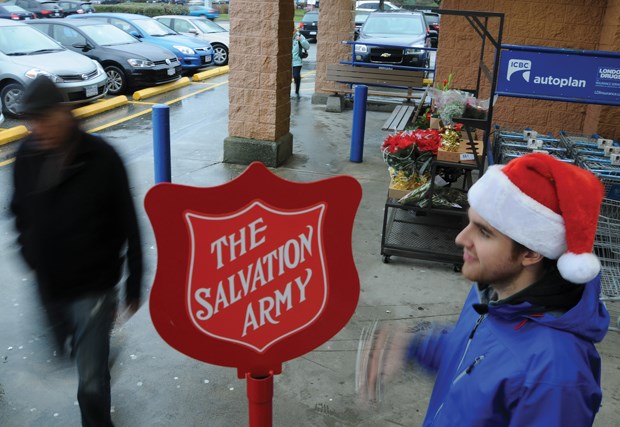Those red kettles that suddenly appear at shopping malls and on street corners around the holidays might look easy to dismiss, but much more goes into them than just your loose change.
When my editor asked me to go “undercover” to do a story about a day in the life of a Salvation Army Christmas kettle keeper, I jumped at the opportunity.
What reporter doesn’t want to go undercover? Who wouldn’t want to stand outside in the frigid cold for hours, trying to ring a bell in an attempt at something called “rhythm,” while being glowered at by passing shoppers?
OK, I had my skepticism about the assignment, just as others might be skeptical about donating to the Sally Ann in the first place.
Despite my reservations, however, I quickly learned the benefit of the kettle campaign extends beyond the boatloads of money it raises for those in need every year – and the ire it seems to raise in some.
“It’s our largest fundraiser by far,” said Brian Dueck, Christmas kettle co-ordinator at the North Shore Salvation Army. “If we didn’t have the kettle campaign then we wouldn’t be able to do what we do here 364 days a year.”
The North Shore Salvation Army is hoping the kettle campaign can raise $350,000 this holiday season. The money will go right back into Sally Ann programs, everything from providing subsidized meals for lower income families, to support services and events for the community. It might feel like a moot point for the many that don’t use the Sally Ann, but for the many that do the organization’s presence can mean the difference between eating a meal that day or not.
(Christmas is the one day of the year the organization takes off. But don’t worry, clients can order their Christmas dinners from the Sally Ann in advance.)
After a short orientation, and with a Santa hat flopped over my head, I trudged out to an Upper Lonsdale London Drugs to man my kettle. I was surprisingly nervous. The kettle shifts generally last a minimum of two hours, but I had a sneaking suspicion my cover would be blown before then. I figured passing shoppers would discover they were dealing with an imposter and call me out on it.
How foolish was I when I learned that a simple smile and a friendly gesture goes a long way in connecting with someone, anyone, who happens to be passing by. No one was out to “get” me. And in fact most were there to lend their support.
“I was a kettler for years,” said one woman, as she put some change into the kettle. “And my sister counted the money for the Sally Ann. She’d be up way late into the night counting.”
Minutes later a man slowly walked by the kettle without offering any money. But he did give up some genuine words of gratitude: “Thank you for doing this,” he said.
You hear stories of kettle volunteers being harassed by the public, robbed in some cases, and I’m not doubting it could happen, either. I’d say standing around shaking a bell for six hours right next to a kettle full of money is a pretty open invitation for attention, wanted or unwanted. But I experienced neither hostility nor contempt during my stint at it.
There was some coldness on display from the more hardened citizens who passed me by, but overall people were friendly and engaged with me as I stood there ringing my bell.
For the few hours I volunteered with the kettle campaign, I felt connected to the community. Kettle volunteers raise a lot of money for those in need, but just as importantly they provide an essential service by being out there and communicating with folks around the North Shore.
After speaking with a woman for a few minutes, for example, she leaned in closer and admitted, “You guys are in my will,” before she walked away. I assumed the “you guys” meant the Sally Ann. Talk about commitment to a cause.
Dueck said that it’s the Sally Ann’s desire to be a presence during the holidays, where on a good day a single kettle can raise $700.
“We don’t see it as us helping the community, we see it as the community coming together to help each other. Whether by volunteering, by donating, it’s just the community coming together to lift one another up through the Christmas season and hopefully that lasts throughout the year as well,” he said.
One woman said she would have dropped more money into the kettle, but claimed “everything is done with Visa these days.” She left behind what change she had instead. Near the end of my shift, a woman put $20 into the kettle and scuttled away, but not before first throwing me an approving wink and a nod. An acknowledgement of our mutual contributions to a worthy cause.
I left my gig as a kettle volunteer cold, fatigued, sore in one hand (from ringing the bell), but also blown away by peoples’ generosity and desire to engage. What else goes into those Christmas kettles besides money? I guess you could say a whole lot.



